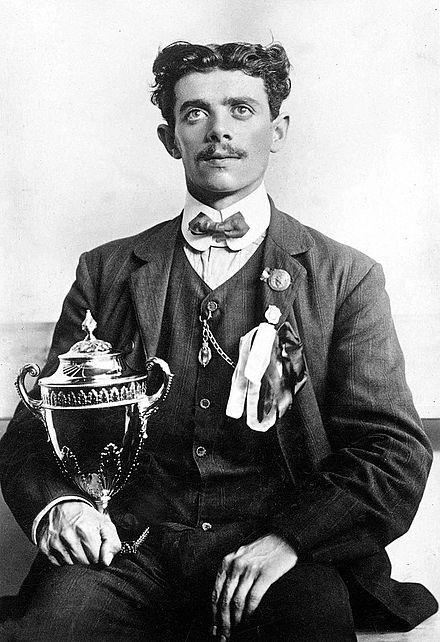This Day in Track & Field/X-Country–November 25
1859–Leading from the start, Great Britain’s William Way ran 2:04.0 at Oxford to set a “world record” for 880-yards.
1908–The dramatic ending to the Olympic Marathon in London in July drew worldwide attention. Italian Dorando Pietri staggered across the finish line in first place, but was disqualified for receiving aid from well-meaning officials. American Johnny Hayes was declared the winner and the clamor for a rematch began almost immediately. One was arranged–but it would be held indoors on the small track at NY’s famed Madison Square Garden! The race would require the runners to circle the Garden’s 10-laps to-the-mile track a mere 262 times!
The Garden was packed with supporters of both runners, with national pride evidenced by American and Italian flags flying all over the place.
Pietri led for most of the race, and when he crossed the 26-mile mark in the lead, his fans thought the race was over and swarmed onto the track. Emotions were high, with fights breaking out as police and officials did their best to allow the runners to complete the final two laps. A path was finally cleared, with Pietri winning by less than a minute over Hayes (2:44:20-2/5 to 2:45:03-1/5). The NY Times called it the “…most spectacular foot race that New York ever has witnessed” and the event was so popular that a number of similar professional races ensued, with Pietri beating Hayes a 2nd time before taking on other challengers.
https://www.newyorker.com/sports/sporting-scene/how-new-york-city-made-the-modern-marathon
1940–Ashland’s Gil Dodds, later known as “The Flying Parson”, won the individual title (4-Miles), while Indiana edged Eastern Michigan (known as Michigan Normal at the time) for the team title (65-68) at the 3rd NCAA X-Country Championships in East Lansing, Michigan. Dodds would go on to become one of America’s best milers, setting a U.S. Record of 4:06.5 in 1943, three World Indoor Records, and winning three Wanamaker Miles at the Millrose Games. He won the Sullivan Award, given to the nation’s top amateur, in 1943.
2nd in the race was Notre Dame’s Ollie Hunter, who would win the 1942 NCAA title.
Results:
(10 teams, 90 finishers)
CLICK HERE to Read the Full Original Article at runblogrun…

